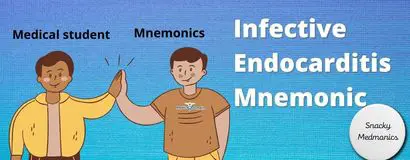
Have you been looking for mnemonic to remember Infective endocarditis?
Yesterday, I went for a mop-up clinical posting at the Cardiology unit. And our consultant diagnosed a patient with Biventricular heart failure and Infective endocarditis.
So today, I am going to review all about Infective endocarditis. You’d learn all about what it means, how to clerk such patients and things to check, and yes, an easy mnemonic to remember the signs and symptoms!
If you are ready for this, then let’s hop in immediately!
First of all, what is Infective Endocarditis?
What is Infective Endocarditis?
What comes to your mind anytime you hear –it is? Inflammation, right? Perfect answer!
So from the word endocardium and inflammation. You should already have a hint on what this disease means!
Infective endocarditis is a disease where the lining of the heart chamber and valves which is the endocardium is inflamed. It simply means a condition where the endocardium of a patient’s heart is inflamed.
This disease is caused by bacteria, fungi, or other microbial organisms that got into the bloodstream.
Causes of Infective endocarditis
Before we move over to the infective endocarditis mnemonic, let’s review what causes it. Here are some ways one can get this disease;
1.Bad Dental Hygiene
Your mouth can get infected with germs through different things that get into it. As a result, health experts advise brushing at least twice a day to keep your teeth clean and free from such germs.
However, poor dental hygiene can cause your gums to bleed during brushing. And when such happens, those germs can sip into your bloodstream and may go all the way to your heart and infect the endocardium causing infective endocarditis.
2. Contaminated instruments
For some patients who do self-medication, they may inject themselves with contaminated needles during drug intake. And when this happens, the blood can get infected through the needles and get into the heart causing infective endocarditis.
3. Infected Catheter
Catheterization is the process by which a medical specialist inserts a thin tube into the body of a patient in order to inject or drain fluid. However, when this tube is in position for a long time, it can get infected and cause infective endocarditis.
How do you clerk a patient with Infective endocarditis?
Obviously, your patient won’t have the term “infective endocarditis” written on their forehead. So how do you detect patients with such disease when they present to your clinic as a medical professional?
Here are symptoms to check for in a patient with Infective endocarditis.
- Fatigue
- Otopnea
- Pedal or abdominal swelling
- Joint and muscle aches
- Heart murmur
- Fever
- Chest pain on exertion
- Janeway lesions: this is described as inflamed spots on soles of the feet or palms
- Oslers nodes: Tender spots under the fingers or toes
- Red spots in the eyes or mouth
Infective Endocarditis Mnemonic
To remember Infective endocarditis symptoms, use the mnemonic: FROM JANE. Where;
- F- Fever
- R- Roth’s spots
- O- Osler’s nodes
- M- Murmurs of the heart
- J- Janeway lesions
- A- anaemia
- N- Nail haemorrhage
- E- Embolism
Duke’s Criteria for infective endocarditis and mnemonic
Making a diagnosis for Infective endocarditis may be difficult as a Doctor. But don’t worry! Duke’s criteria is here for you!
Duke criteria are a collection of features to check for a complete diagnosis for Infective endocarditis. It requires you to have one of the following before you can decide:
- 2 major and 1 minor criterion or
- 1 major and 3 minor criterion
- 5 minor criterion
Major Criterion
1.Blood culture positive for infective endocarditis
When you get the test for the blood culture of the patient, if you find either of Staphylococcus Aureus, Viridans Streptococci, Staphylococcus Bovis, HACEK group, community acquired enterococci, then you should know the patient has infective endocarditis.
2. Endochardial involvement
When an echocardiograph is done on the patient, the presence of vegetation, absence or valve dehiscence signifies infective endocarditis. Also, an increase in murmur shows positive for the disease
Minor criteria for infective endocarditis mnemonic
3. Fever
4. Immunological events which include symptoms like Osler’s nodes, Rheumatoid factor, Roth spots.
5. Vascular lesions which include embolism, Janeway lesions, hemorrhage, Intracranial hemorrhage, conjunctival hemorrhage, septic infarcts.
6. Echocardiography
7. Predeposition: that is what is the heart condition or is the patient on IV drugs?
8. Microbiological findings
Following the Duke criteria, if you want to easily remember the symptoms and their order then use the mnemonic: BE FIVE PM. They are already arranged in the above.
Also Read: Glasgow Coma Scale Mnemonic for easy recall
Final words on Infective endocarditis
In this article, we have come to review all about the infective endocarditis disease as well as an easy mnemonic to remember them anytime! Now you can proceed and make a perfect diagnosis!